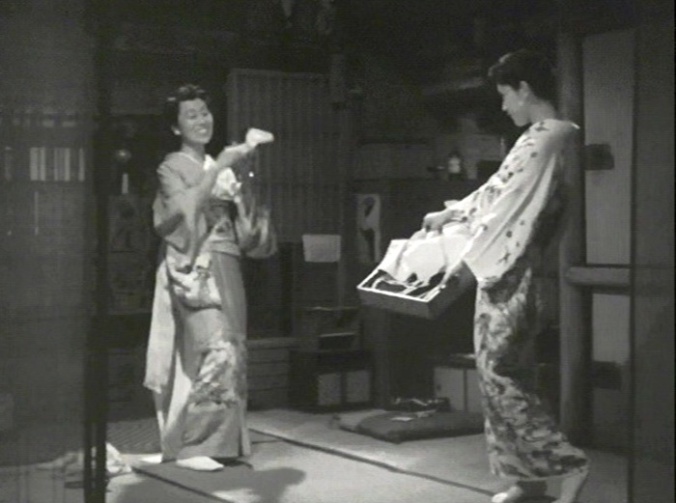
Two geishas return tipsy from a party
As a result of its date, Naruse’s Flowing is often compared to Mizoguchi’s Street of Shame, but it is much closer to the Woman of Rumor.
Again we are inside a geisha house with a daughter who wants no part of the business, but it operates on a far different level than the one in Woman of Rumor. Here the geishas appear to live in the house but not work in the house, so that the mother Otsuta is more of an agent/manager for the women than the owner of a full-service operation such as Tanaka ran in Mizoguchi’s film. And there is no doubt whatsoever that the women are geisha/entertainers only. As two discuss when they return from a party, it is fun when you have the party and the music and all you have to do is say silly things to men. One of the women eventually leaves at her father’s insistence to go work in a brothel, so clearly that kind of work was not available here. Thus, it becomes a sympathetic, almost nostalgic look at one of the most traditional of all Japanese traditions as it is slowly being destroyed by the changes of modern Japan. The precarious nature of that cultural change is especially vivid in the scenes with a grand-daughter being trained in the arts while the daughters of the family refuse to continue the family trade, and the nostalgia can be seen in the scene when a new geisha in the district is brought round for her formal introduction and the women coo and gush over her like she was a new baby, even though she is yet more competition for the older women in this house.
- Isuzu Yamada
- Hideko Takamine
- Kinuyo Tanaka
- Geisha in training
Nevertheless, business is bad, and one of the daughters (Hideko Takamine) even tries to help out by taking in sewing jobs (though how she thinks she can make more that way than by taking geisha fees, for which she has been trained, is never quite clear). But the greatest problem is that Otsuta (Isuzu Yamada) , already abandoned by her husband, now carries a large debt that she took out to help a lover who then also left her. The number of women in Japanese movies who are running a business or have sold themselves to support a man who is ill, can’t make a living himself, or simply takes no interest seems to be innumerable. And this doesn’t even consider the men who take the woman’s money and run off, usually but not always with another woman.
To make matters worse, Otsuta’s debt is owed to her own sister. When Otsuta refuses the new patron her sister sets up for her, the sister in effect forecloses. But remember, the sister is in effect claiming that Otsuta has sold herself to the sister and should sleep with whomever the sister chooses.
More than any other nation’s cinema that I know enough about to make generalizations, Japan’s modern-dress movies are willing to talk about money. All situations and relationships outside and often inside the immediate family involve money borrowed, money owed, money demanded, and even in many period films it is the need for money, not greed but a basic need just to survive, that leads to, for example, the selling of daughters. Only in the deepest Depression years did American movies suggest that money was a controlling factor in life for any but the most greedy. And almost all loans are personal loans — Japan came to modern banking much later than any other industrialized nation, so we almost never see the common American scene of the person at the bank manager’s desk. Even within that general culture, I think Naruse’s movies are even more aware of the role money plays than usual; in his best movies, particularly during the fifties, he deals almost exclusively with women from the class that is just above true poverty, where a relatively small amount of money becomes extremely important, as it does here.
All of this is observed by the faithful maid (Kinuyo Tanaka), who provides the grounding that reminds us who are the good people and who the not-so-good.
As with most of Naruse’s josei-eiga, the direction is so transparent that you fail to notice it. The weepier, more melodramatic aspects are downplayed, perhaps because the men themselves are all but invisible. And it almost goes without saying, and should therefore be said, the performances are complex, detailed, and utterly believable. According to most accounts, Naruse was a very frustrating director to work for because he almost never actually gave direction to his cast members, much like Woody Allen today. And yet, somehow, the performances are impeccable.




Pingback: A Geisha / Gion bayashi (1953) | Japanonfilm
Pingback: Clothes of Deception / Under Silk Garments / Itsuwareru seiso (1951) | Japanonfilm
Pingback: Geisha / Yokiro (1983) | Japanonfilm
Pingback: The Sea is Watching / Umi wa miteita (2002) | Japanonfilm